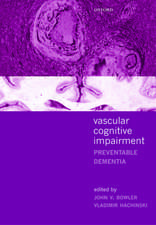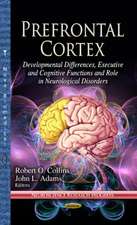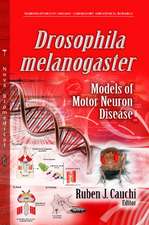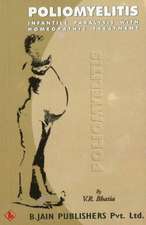Neuropathology: A Volume in the High Yield Pathology Series (Expert Consult - Online and Print): High Yield Pathology
Autor Anthony T. Yachnis, Marie L Rivera-Zengotitaen Limba Engleză Hardback – 26 feb 2013
Preț: 1019.64 lei
Preț vechi: 1378.80 lei
-26% Nou
Puncte Express: 1529
Preț estimativ în valută:
195.15€ • 202.95$ • 163.30£
195.15€ • 202.95$ • 163.30£
Carte disponibilă
Livrare economică 28 februarie-12 martie
Preluare comenzi: 021 569.72.76
Specificații
ISBN-13: 9781416062202
ISBN-10: 1416062203
Pagini: 368
Ilustrații: Approx. 806 illustrations (806 in full color)
Dimensiuni: 222 x 281 x 22 mm
Greutate: 1.27 kg
Editura: Elsevier
Seria High Yield Pathology
ISBN-10: 1416062203
Pagini: 368
Ilustrații: Approx. 806 illustrations (806 in full color)
Dimensiuni: 222 x 281 x 22 mm
Greutate: 1.27 kg
Editura: Elsevier
Seria High Yield Pathology
Cuprins
I.
BASIC
REACTIONS
A. Cerebral Edema
B. Hydrocephalus
C. Herniations
II. DEVELOPMENTAL DISORDERS
A. Malformations
Neural Tube Defects
Holoprosencephaly
Posterior Fossa: Chiari Malformations
Cerebellar Vermis Malformations
Lhermitte-Duclos Disease
Neuronal Migration Defects
B. Acquired Developmental Defects
Germinal Matrix Hemorrhage
Periventricular Leukomalacia
Gray Matter Lesions
Porencephaly
III. CEREBROVASCULAR DISORDERS
A. Cerebral Ischemia and Hypertensive Changes
Ischemic Cerebrovascular Disease
Hypertensive Cerebrovascular Disease: Ischemic Changes
Hypertensive Cerebrovascular Disease: Spontaneous Intracerebral Hemorrhage
Hypertensive Cerebrovascular Disease: Posterior Reversible Encephalopathy Syndrome (PRES)
B. Intracranial Aneurysms
Saccular ("Berry") Aneurysms
Fusiform Aneurysms
Infective ("Mycotic") Aneurysms
C. Vascular Malformations
Arteriovenous Malformations (AVM)
Cavernous Angiomas (CA)
Capillary Telangiectasis
Venous Angioma
D. Vasculitis
Giant Cell Arteritis
Polyarteritis Nodosa (PAN)
Primary CNS Angiitis
E. Inherited Cerebrovascular Diseases
Cerebral Amyloid Angiopathy
Cerebral Autosomal Dominant Ateriopathy with Subcortical Infarcts and Leukoencephalopathy (CADASIL)
Moyamoya Syndrome
IV. TRAUMA
A. Closed vs Open (Penetrating) Head Trauma
Contusion/Laceration (Including Coup and Contra Coup Lesions)
Diffuse Axonal Injury (Diffuse Traumatic Brain Injury)
B. Traumatic Intracranial Hemorrhage
Epidural Hematoma
Subdural Hematoma
V. BRAIN TUMORS
A. Diffuse Gliomas-Astrocytic
Diffuse Astrocytoma
Anaplastic Astrocytoma
Glioblastoma
Glioblastoma Variants
B. Diffuse Gliomas-Oligdendroglial
Oligodendroglioma
Anaplastic Oligodendroglioma
Mixed Glioma (Oligosatrocytoma, Anaplastic Oligoastrocytoma)
Gliomatosis Cerebri
C. Other Astrocytic Tumors
Pleomorphic Xanthoastrocytoma (PXA)
Pilocytic Astrocytoma
Subependymal Giant Cell Astrocytoma
D. Ependymomas and Subependymoma
Ependymoma
Anaplastic Ependymoma
Myxopapillary Ependymoma
Subependymoma
E. Tumors with Ependymal-like Features
Angiocentric Glioma
Chordoid Glioma
Astroblastoma
F. Choroid Plexus Tumors
Choroid Plexus Papilloma
Choroid Plexus Carcinoma
G. Neuronal and Glioneuronal Tumors
Ganglion Cell Tumors
Desmoplastic Infantile Astrocytoma/Ganglioglioma
Central Neurocytoma
Dysembryoplastic Neuroepithelial Tumor (DNET)
Papillary Glioneuronal Tumor
Rosette-Forming Glioneuronal Tumor of the Fourth Ventricle
H. Embryonal (Primitive) Neuroepithelial Tumors
Medulloblastoma
Central Nervous System - Primitive Neuroectodermal Tumor (CNS-PNET)
Atypical Teratoid/Rhabdoid Tumors (AT/RT)
I. Meningiomas (Tumors of the Meninges)
Meningioma: Overview and General Characteristics
Meningioma: WHO Grade I Variants
Atypical Meningioma
Malignant (Anaplastic) Meningiomas
Hemangiopericytoma: Solitary Fibrous Tumor
J. Nerve Sheath Tumors
Schwannoma
Neurofibroma
Perineurioma
Malignant Peripheral Nerve Sheath Tumor (MPNST)
K. Primary CNS Lymphoma (PCNSL)
L. Pineal Parenchymal Tumors
Pineocytoma
Pineal Parenchymal Tumor of Intermediate Differentiation
Pineoblastoma
Papillary Tumor of the Pineal Region
M. Germ Cell Tumors of the Central Nervous System
Germinoma
Other Germ Cell Tumors
N. Hemangioblastoma
O. Sellar and Suprasellar Tumors
Pituitary adenomas
Pituicytoma
Cranopharyngioma
Rathke cleft cyst
Langerhans cell histiocytosis
P. Primary Melanocytic Tumors of the Central Nervous System
Q. Central Nervous System Cysts
R. Metastatic Brain Tumors
S. Tumors of the Skull Base
Chordoma of Skull Base
Chondrosarcoma of Skull Base
VI. INFECTIOUS DISEASES
A. Bacterial Infections
Acute Purulent Meningitis
Cerebral Bacterial Abscess
Nocardia/Actinomycetes Species
Mycobacterial Infection
Neurosyphilis
B. Mycoses
Cerebral Cryptococcosis
Aspergillosis
Mucormycosis
Candidiasis
C. Parasitic Infections
Cerebral Toxoplasmosis
Cerebral Cystecercosis
Primary Amoebic Meningoencephalitis
Granulomatous Amoebic Encephalitis
Cerebral Malaria
D. Viral Infections
General viral effects on the nervous system
Herpes Simplex Encephalitis
Cytomegalovirus Encephalitis
Rabies encephalitis
Arboviruses
Progressive Multifocal Leukoencephalopathy
E. Neuropathology of AIDS
Primary effects of HIV infection
HIV-Associated Vacuolar Myelopathy (HAM)
Opportunistic CNS Infections in AIDS
CNS Immune Reconstitution Inflammatory Syndrome (Neuro-IRIS)
F. Prion Diseases
Prion-related diseases (Overview)
Creutzfeldt-Jacob disease
Other prion-related diseases
VII. Neurodegenerative disorders
A. Alzheimer's Disease
B. Frontotemporal Lobar Degenerations and Related Tauopathies
Corticobasal Degeneration (Rebeiz Disease)
Progressive Supranuclear Palsy (PSP: Steele-Richardson-Olszewski Syndrome)
Pick Disease
Frontotemporal Lobar Degeneration: Frontotemporal Dementia and Parkinsonism Linked to Chromosome 17 (FTDP-17)
C. Frontotemporal Lobar Degenerations with Ubiquitin-Inclusions (FTLD-U/FTLD-MND (TDP-43)
D. Parkinson's Disease and Related Alpha-Synucleinopathies
Parkinson's Disease
Dementia with Lewy Bodies
Multiple System Atrophy (MSA)
E. Amyotrophic Lateral Sclerosis (ALS)
F. Triple-Repeat Inherited Neurodegenerations
Huntington Disease
Autosomal Recessive Spinocerebellar Degeneration (Friedrich's Ataxia)
Autosomal Dominant Spinocerebellar Ataxias (SCA)
Fragile X Tremor / Ataxia Syndrome
G. Neuroaxonal Dystrophies
Neurodegeneration with brain iron accumulation type 1 (NBIA 1)
Other inherited neuroaxonal dystrophies
H. Vascular Dementia and Binswanger Disease
VIII. DEMYELINATING DISEASES
A. Multiple sclerosis
Multiple Sclerosis
Neuromyelitis Optica Spectrum Disorders
B. Acute Disseminated Leukoencephalitis
C. Acute Hemorrhagic Leukoencephalitis (Hurst Disease)
D. Tumefactive Demyelinating Lesions (TDL)
IX. TOXIC, NUTRITIONAL, METABOLIC DISEASES
A. Toxic Injury
Toxic Leukoencephalopathy
Carbon monoxide
Ethanol-related injury (including superior vermis atrophy and central pontine myelinolysis)
Hepatic encephalopathy
B. Nutritional Diseases
Wernicke-Korsakoff disease
Subacute Combined Degeneration
C. Metabolic Diseases
Neuronal Storage Disease
Leukodystrophies
Neuronal Ceroid Lipofuscinosis
Wilson Disease (Hepatolenticular Degeneration)
Alexander disease
X. Neuromuscular disorders
A. Peripheral Nerve Disease
Basic reactions in peripheral nerve disorders
Immune-Mediated Inflammatory Neuropathies
Charcot-Marie-Tooth disease and related congenital neuropathies
B. Skeletal Muscle Diseases
Essential Features: Myopathic versus Neurogenic Changes
Dermatomyositis
Polymyositis
Inclusion Body Myopathy and Myositis
Dystrophinopathies (Duchenne and Becker Muscular Dystrophy
Myotonic Dystrophies
Periodic Paralysis
Limb-Girdle Muscular Dystrophies
Nemaline Myopathy
Central Core Disease
Pompe Disease
McArdle Disease
Mitochondiral Myopathies
A. Cerebral Edema
B. Hydrocephalus
C. Herniations
II. DEVELOPMENTAL DISORDERS
A. Malformations
Neural Tube Defects
Holoprosencephaly
Posterior Fossa: Chiari Malformations
Cerebellar Vermis Malformations
Lhermitte-Duclos Disease
Neuronal Migration Defects
B. Acquired Developmental Defects
Germinal Matrix Hemorrhage
Periventricular Leukomalacia
Gray Matter Lesions
Porencephaly
III. CEREBROVASCULAR DISORDERS
A. Cerebral Ischemia and Hypertensive Changes
Ischemic Cerebrovascular Disease
Hypertensive Cerebrovascular Disease: Ischemic Changes
Hypertensive Cerebrovascular Disease: Spontaneous Intracerebral Hemorrhage
Hypertensive Cerebrovascular Disease: Posterior Reversible Encephalopathy Syndrome (PRES)
B. Intracranial Aneurysms
Saccular ("Berry") Aneurysms
Fusiform Aneurysms
Infective ("Mycotic") Aneurysms
C. Vascular Malformations
Arteriovenous Malformations (AVM)
Cavernous Angiomas (CA)
Capillary Telangiectasis
Venous Angioma
D. Vasculitis
Giant Cell Arteritis
Polyarteritis Nodosa (PAN)
Primary CNS Angiitis
E. Inherited Cerebrovascular Diseases
Cerebral Amyloid Angiopathy
Cerebral Autosomal Dominant Ateriopathy with Subcortical Infarcts and Leukoencephalopathy (CADASIL)
Moyamoya Syndrome
IV. TRAUMA
A. Closed vs Open (Penetrating) Head Trauma
Contusion/Laceration (Including Coup and Contra Coup Lesions)
Diffuse Axonal Injury (Diffuse Traumatic Brain Injury)
B. Traumatic Intracranial Hemorrhage
Epidural Hematoma
Subdural Hematoma
V. BRAIN TUMORS
A. Diffuse Gliomas-Astrocytic
Diffuse Astrocytoma
Anaplastic Astrocytoma
Glioblastoma
Glioblastoma Variants
B. Diffuse Gliomas-Oligdendroglial
Oligodendroglioma
Anaplastic Oligodendroglioma
Mixed Glioma (Oligosatrocytoma, Anaplastic Oligoastrocytoma)
Gliomatosis Cerebri
C. Other Astrocytic Tumors
Pleomorphic Xanthoastrocytoma (PXA)
Pilocytic Astrocytoma
Subependymal Giant Cell Astrocytoma
D. Ependymomas and Subependymoma
Ependymoma
Anaplastic Ependymoma
Myxopapillary Ependymoma
Subependymoma
E. Tumors with Ependymal-like Features
Angiocentric Glioma
Chordoid Glioma
Astroblastoma
F. Choroid Plexus Tumors
Choroid Plexus Papilloma
Choroid Plexus Carcinoma
G. Neuronal and Glioneuronal Tumors
Ganglion Cell Tumors
Desmoplastic Infantile Astrocytoma/Ganglioglioma
Central Neurocytoma
Dysembryoplastic Neuroepithelial Tumor (DNET)
Papillary Glioneuronal Tumor
Rosette-Forming Glioneuronal Tumor of the Fourth Ventricle
H. Embryonal (Primitive) Neuroepithelial Tumors
Medulloblastoma
Central Nervous System - Primitive Neuroectodermal Tumor (CNS-PNET)
Atypical Teratoid/Rhabdoid Tumors (AT/RT)
I. Meningiomas (Tumors of the Meninges)
Meningioma: Overview and General Characteristics
Meningioma: WHO Grade I Variants
Atypical Meningioma
Malignant (Anaplastic) Meningiomas
Hemangiopericytoma: Solitary Fibrous Tumor
J. Nerve Sheath Tumors
Schwannoma
Neurofibroma
Perineurioma
Malignant Peripheral Nerve Sheath Tumor (MPNST)
K. Primary CNS Lymphoma (PCNSL)
L. Pineal Parenchymal Tumors
Pineocytoma
Pineal Parenchymal Tumor of Intermediate Differentiation
Pineoblastoma
Papillary Tumor of the Pineal Region
M. Germ Cell Tumors of the Central Nervous System
Germinoma
Other Germ Cell Tumors
N. Hemangioblastoma
O. Sellar and Suprasellar Tumors
Pituitary adenomas
Pituicytoma
Cranopharyngioma
Rathke cleft cyst
Langerhans cell histiocytosis
P. Primary Melanocytic Tumors of the Central Nervous System
Q. Central Nervous System Cysts
R. Metastatic Brain Tumors
S. Tumors of the Skull Base
Chordoma of Skull Base
Chondrosarcoma of Skull Base
VI. INFECTIOUS DISEASES
A. Bacterial Infections
Acute Purulent Meningitis
Cerebral Bacterial Abscess
Nocardia/Actinomycetes Species
Mycobacterial Infection
Neurosyphilis
B. Mycoses
Cerebral Cryptococcosis
Aspergillosis
Mucormycosis
Candidiasis
C. Parasitic Infections
Cerebral Toxoplasmosis
Cerebral Cystecercosis
Primary Amoebic Meningoencephalitis
Granulomatous Amoebic Encephalitis
Cerebral Malaria
D. Viral Infections
General viral effects on the nervous system
Herpes Simplex Encephalitis
Cytomegalovirus Encephalitis
Rabies encephalitis
Arboviruses
Progressive Multifocal Leukoencephalopathy
E. Neuropathology of AIDS
Primary effects of HIV infection
HIV-Associated Vacuolar Myelopathy (HAM)
Opportunistic CNS Infections in AIDS
CNS Immune Reconstitution Inflammatory Syndrome (Neuro-IRIS)
F. Prion Diseases
Prion-related diseases (Overview)
Creutzfeldt-Jacob disease
Other prion-related diseases
VII. Neurodegenerative disorders
A. Alzheimer's Disease
B. Frontotemporal Lobar Degenerations and Related Tauopathies
Corticobasal Degeneration (Rebeiz Disease)
Progressive Supranuclear Palsy (PSP: Steele-Richardson-Olszewski Syndrome)
Pick Disease
Frontotemporal Lobar Degeneration: Frontotemporal Dementia and Parkinsonism Linked to Chromosome 17 (FTDP-17)
C. Frontotemporal Lobar Degenerations with Ubiquitin-Inclusions (FTLD-U/FTLD-MND (TDP-43)
D. Parkinson's Disease and Related Alpha-Synucleinopathies
Parkinson's Disease
Dementia with Lewy Bodies
Multiple System Atrophy (MSA)
E. Amyotrophic Lateral Sclerosis (ALS)
F. Triple-Repeat Inherited Neurodegenerations
Huntington Disease
Autosomal Recessive Spinocerebellar Degeneration (Friedrich's Ataxia)
Autosomal Dominant Spinocerebellar Ataxias (SCA)
Fragile X Tremor / Ataxia Syndrome
G. Neuroaxonal Dystrophies
Neurodegeneration with brain iron accumulation type 1 (NBIA 1)
Other inherited neuroaxonal dystrophies
H. Vascular Dementia and Binswanger Disease
VIII. DEMYELINATING DISEASES
A. Multiple sclerosis
Multiple Sclerosis
Neuromyelitis Optica Spectrum Disorders
B. Acute Disseminated Leukoencephalitis
C. Acute Hemorrhagic Leukoencephalitis (Hurst Disease)
D. Tumefactive Demyelinating Lesions (TDL)
IX. TOXIC, NUTRITIONAL, METABOLIC DISEASES
A. Toxic Injury
Toxic Leukoencephalopathy
Carbon monoxide
Ethanol-related injury (including superior vermis atrophy and central pontine myelinolysis)
Hepatic encephalopathy
B. Nutritional Diseases
Wernicke-Korsakoff disease
Subacute Combined Degeneration
C. Metabolic Diseases
Neuronal Storage Disease
Leukodystrophies
Neuronal Ceroid Lipofuscinosis
Wilson Disease (Hepatolenticular Degeneration)
Alexander disease
X. Neuromuscular disorders
A. Peripheral Nerve Disease
Basic reactions in peripheral nerve disorders
Immune-Mediated Inflammatory Neuropathies
Charcot-Marie-Tooth disease and related congenital neuropathies
B. Skeletal Muscle Diseases
Essential Features: Myopathic versus Neurogenic Changes
Dermatomyositis
Polymyositis
Inclusion Body Myopathy and Myositis
Dystrophinopathies (Duchenne and Becker Muscular Dystrophy
Myotonic Dystrophies
Periodic Paralysis
Limb-Girdle Muscular Dystrophies
Nemaline Myopathy
Central Core Disease
Pompe Disease
McArdle Disease
Mitochondiral Myopathies


















